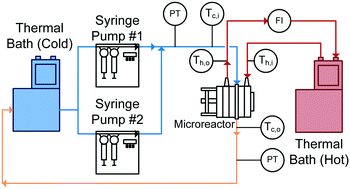当前位置:
X-MOL 学术
›
React. Chem. Eng.
›
论文详情
Our official English website, www.x-mol.net, welcomes your feedback! (Note: you will need to create a separate account there.)
Local and overall heat transfer of exothermic reactions in microreactor systems
Reaction Chemistry & Engineering ( IF 3.9 ) Pub Date : 2017-09-05 00:00:00 , DOI: 10.1039/c7re00085e Eric Mielke 1, 2, 3, 4, 5 , Patrick Plouffe 1, 2, 3, 4, 5 , Nikhil Koushik 1, 2, 3, 4, 5 , Markus Eyholzer 6, 7, 8, 9 , Michael Gottsponer 6, 7, 8, 9 , Norbert Kockmann 10, 11, 12, 13, 14 , Arturo Macchi 1, 2, 3, 4, 5 , Dominique M. Roberge 6, 7, 8, 9
Reaction Chemistry & Engineering ( IF 3.9 ) Pub Date : 2017-09-05 00:00:00 , DOI: 10.1039/c7re00085e Eric Mielke 1, 2, 3, 4, 5 , Patrick Plouffe 1, 2, 3, 4, 5 , Nikhil Koushik 1, 2, 3, 4, 5 , Markus Eyholzer 6, 7, 8, 9 , Michael Gottsponer 6, 7, 8, 9 , Norbert Kockmann 10, 11, 12, 13, 14 , Arturo Macchi 1, 2, 3, 4, 5 , Dominique M. Roberge 6, 7, 8, 9
Affiliation

|
Non-reactive and reactive heat transfer experiments were performed in the FlowPlate® system manufactured by Ehrfeld Mikrotechnik, which is composed of alternating reactor and heat transfer fluid plates within a rack. The non-reactive model system studied a rectangular serpentine channel with Reynolds numbers ranging from 400–2000, and a Gnielinski-type model was fit to the internal Nusselt number. A silver-based thermal paste was shown to reduce the external resistance to heat transfer between the reactor and heat transfer fluid plates by ∼70%, leading to overall heat transfer coefficients of ∼2200 W m−2 K−1. In the reactive system, the synthesis of methyl 2-oxobutanoate, using dimethyl-oxalate and the Grignard reagent ethylmagnesium chloride, was highlighted as a test reaction to differentiate localized heat transfer characteristics across different reactors. The Grignard reaction was used to compare the impact of various micro-mixer geometries, materials, injection ports, and scales on hotspot formation in the reactors. Finally, an analysis of four case studies that can be extended to any micro-reactor system with known overall heat transfer coefficients was presented using the fourth Damköhler number to determine a maximum channel diameter that would remove energy sufficiently quick to avoid hotspot formation.
中文翻译:

微反应器系统中放热反应的局部和整体传热
非反应性和反应性传热实验是在Ehrfeld Mikrotechnik制造的FlowPlate®系统中进行的,该系统由机架内的交替反应器和传热流体板组成。非反应模型系统研究了雷诺数在400-2000之间的矩形蛇形通道,并且Gnielinski型模型适合于内部Nusselt数。已显示银基导热膏可将反应器和导热流体板之间的外部传热阻力降低约70%,从而使总传热系数达到约2200 W m -2 K -1。在反应体系中,使用草酸二甲酯和格氏试剂乙基氯化镁的2-氧代丁酸甲酯的合成作为测试反应得以突出,以区分不同反应器之间的局部传热特性。使用格氏反应来比较各种微型混合器的几何形状,材料,注入口和水垢对反应器中热点形成的影响。最后,使用第四个Damköhler数确定了可以扩展到具有已知整体传热系数的任何微反应器系统的四个案例研究,以确定最大通道直径,该通道直径将足够快地除去能量,从而避免形成热点。
更新日期:2017-10-03
中文翻译:

微反应器系统中放热反应的局部和整体传热
非反应性和反应性传热实验是在Ehrfeld Mikrotechnik制造的FlowPlate®系统中进行的,该系统由机架内的交替反应器和传热流体板组成。非反应模型系统研究了雷诺数在400-2000之间的矩形蛇形通道,并且Gnielinski型模型适合于内部Nusselt数。已显示银基导热膏可将反应器和导热流体板之间的外部传热阻力降低约70%,从而使总传热系数达到约2200 W m -2 K -1。在反应体系中,使用草酸二甲酯和格氏试剂乙基氯化镁的2-氧代丁酸甲酯的合成作为测试反应得以突出,以区分不同反应器之间的局部传热特性。使用格氏反应来比较各种微型混合器的几何形状,材料,注入口和水垢对反应器中热点形成的影响。最后,使用第四个Damköhler数确定了可以扩展到具有已知整体传热系数的任何微反应器系统的四个案例研究,以确定最大通道直径,该通道直径将足够快地除去能量,从而避免形成热点。



























 京公网安备 11010802027423号
京公网安备 11010802027423号